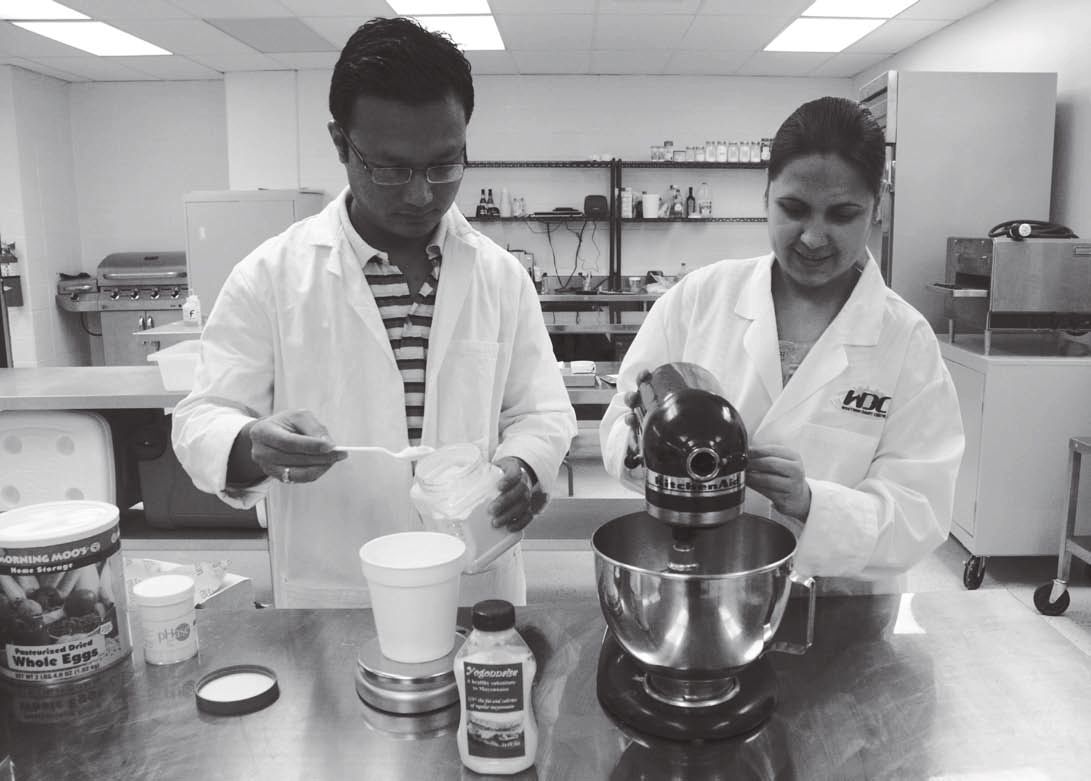
TWO FOOD SCIENTISTS DESIGNED a healthier alternative to mayonnaise called Yogonnaise. This new product contains one-third
the calories of regular mayo, and won first place at an Idaho competition. ANI MIRZAKHANYAN photo
Utah State took first, over BYU and Cornell, in an Idaho dairy product competition and brought home a $10,000 prize,said Bob Ward, assistant professor in food science.
Doctoral candidates Ranjeeta Wadhwani and Subash Shrestha, developers of the mayonnaise substitute Yogonnaise,said their product won the August competition because the judges felt it could be best applied to products already on the market, like salad dressings and sandwiches.
The competition is sponsored by the Idaho Milk Processors’ Association (IMPA), which is an organization of dairy-related companies in Idaho, the fourth largest dairying state in the U.S., Ward said.
IMPA holds the annual event as a way to get new ideas,enrich dairy studies, diversify the market for dairy products and get milk ingredients in other foods, Ward said. The competition is also a platform for recruiting the next generation of students into the field, he said.
“It really ends up pulling together our curriculum. We do these various classes in isolation, and it’s neat to see this sort of synergy when you develop a product like this,” Ward said.
Wadhwani, who is specializing in cheese and dairy science, said she and Shrestha used knowledge gained from food chemistry, food safety and food processing classes to help with the project. Shrestha, whose emphasis is on food safety and quality, said a product development class also played a big part in their success with finalizing the product.
The idea for a product like Yogonnaise was originally conceived by Brian Nummer, extension food safety specialist, Shrestha said. Nummer is also his adviser.
“He had a great idea, two years back, and at the time they couldn’t produce a real product of high enough quality,” Shrestha said, “so we picked it up and worked on it.”
Wadhwani and Shrestha decided to use yogurt as a substitute for the large volume of high-calorie oil that is found in regular mayonnaise, Wadhwani said. Mayonnaise is approximately 80% oil, she said, and in comparison, Yogonnaise is only one-third the calorie content. When they initially tried mixing yogurt with the other ingredients, “It didn’t come out very well,” Wadhwani said.
“We used some emulsifiers; it took us like three months to come to a good product,” Shrestha said. “The new product is quite healthier than regular mayo.”
The two students, under Ward’s guidance, worked on the Yogonnaise project as if they were actually professionals in their field, Wadhwani said. She said Don McMahon, her adviser and professor of food science, co-advised them on the project.
McMahon is also the director of Western Dairy Center at Utah State. The center provided feedback, sponsored product development, and helped fund the project, Ward said.
Wadhwani and Shrestha took their developed product to the local gardeners’ market for a sampling of what tasters thought about their product, Wadhwani said. She said they had 100 people try Yogonnaise and write down what they thought about it.
“We got a lot of good feedback, one person said, ‘I can’t believe it’s lower in calories but tastes exactly like regular mayonnaise,’” Wadhwani said. Yogonnaise has a very similar texture and taste to mayonnaise, she said.
Using yogurt eliminates eggs from the recipe, which makes it possible for vegetarians to use the product, Wadwhani said. Wadhwani, who is from India, said being vegetarian is part of her cultural beliefs, and the judges of the contest asked if she thought people from India would enjoy Yogonnaise. She said she thinks they would.
The judges from IMPA are professionals in the industry, Ward said. They are product developers, dairy workers, and employees for processing companies, he said.
“One of them has a contact at a company that makes high-end salad dressing,” Ward said. He said the judges suggested that Yogonnaise could fit into a few different product lines, including high-end salad dressings for health-conscious consumers Many people around the world are becoming obese and products like this one could help address that problem, Wadhwani said. She said they are open to any companies that would consider using their product.
They had to disclose the recipe to the contest judges to prove the product contained at least 51% dairy, Ward said. The exact formulation has not been made public and they are considering getting a patent, Shrestha said.
Wadhwani said, “Apart from America, I would like to see it globally. Why not Europe? Why not Asia?”
Past Utah State students have entered the IMPA competition, and two years in a row, they took third, Ward said. He said some of the past entries include a cheese-integrated fruit roll and a non-dairy coconut milk ice cream.
Ward said BYU students, who took second, submitted a low-fat ice cream that was designed to promote bone health. Cornell students, the third-place winners, developed a meringue cookie with whey protein, he said.
This was the first time USU took first place, and the first time Wadhwani and Shrestha have competed, Ward said.
“It was nice to carry that big check,” Shrestha said.
“Subash called me and let me know, ‘Hey we won,’ and I was there jumping in my apartment and nobody was there to see me,” Wadhwani said.
The cardboard version of the check and the students’ presentation board are on display in the Nutrition and Food Science Building, which is next to Aggie Ice Cream

